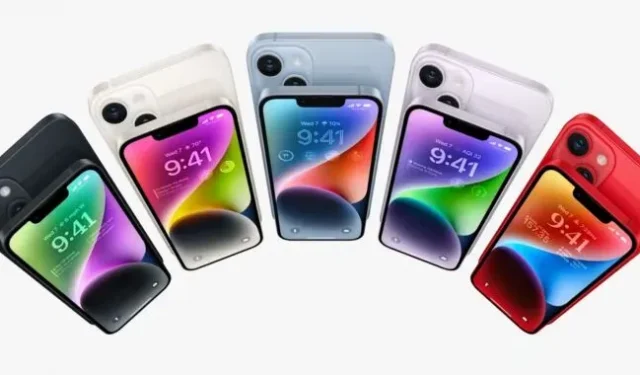CUPERTINO, Calif. — At the first indoor product launch event since the start of the pandemic, Apple today announced the new iPhone 14 lineup.
Like its predecessor, the base iPhone 14 has a 6.1-inch OLED screen. But missing is the iPhone mini, the smaller one-handed model that has been in Apple’s lineup for the previous two years. This phone didn’t sell very well, so most consumers said big phones are the way to go.
So Apple has replaced the mini with an iPhone 14 Plus with a 6.7-inch screen — the same size as the recent iPhone 12 Max and iPhone 13 Max. However, other than that, the specs and features are the same for iPhone 14 and iPhone 14 Plus.
If you were hoping for a big jump in performance from last year, you will be disappointed. Both iPhone 14 models feature the Apple A15 Bionic System on a Chip, exactly the same as last year’s model. As a result, big performance improvements are probably not foreseen here. (However, some early leaks suggested that these new phones have more RAM than their 2021 counterparts.) The chip has 5 GPU cores like last year’s iPhone Pro, 6 CPU cores including 2 high performance cores and 4 efficient cores, as well as a 16-core neural processor.
The displays are rated for a maximum brightness of 1200 with HDR content and a contrast ratio of 2,000,000:1.
Aside from the new larger Plus size, the iPhone 14 looks pretty much the same as last year, including a screen cutout for front sensors and so on. However, Apple has pointed to an updated internal design to improve thermal performance.
Apple also claims that the new iPhone 14 will have the best battery life of any iPhone.
And the iPhone 14 series has camera improvements, including a new 12MP main camera with larger sensors and 1.9 micron pixels. There’s also a faster aperture (f/1.5) for better motion freezing.
Meanwhile, the new TrueDepth front camera has a faster f/1.9 aperture as well as autofocus for the first time. According to Apple, it uses a hybrid system for faster focusing, including in low light conditions, for better selfies and group shots.
Apple’s iPhone 14 series will also use Deep Fusion, a feature that uses machine learning to combine multiple frames into a single image, previously for uncompressed images. This should provide a wider range and brighter colors and is another tactic to improve low light performance.
Ultimately, Apple claims twice the low-light performance for the iPhone 14 series front camera, twice the low-light performance for the ultra-wide rear camera, and 2.5 times the low-light performance for the new main camera.
For video shooting, there is a more advanced stabilization mode called Action Mode.
Apple also announced that the iPhone 14s in the US will not have a SIM tray. They will only rely on eSIM.
Future smartphones are also bringing some security features to the iPhone, similar to those found on the Apple Watch. There’s a new gyroscope and accelerometer. Apple also introduced Emergency SOS, which works via satellite. It uses special components and software so the iPhone 14’s antennas can connect to satellites even when they’re moving. Apple achieved this by creating a short text compression algorithm to reduce the size of a message so it can take anywhere from 15 seconds to several minutes to be sent, depending on sky conditions.
The phones will be available in five colors: midnight, starlight, blue, purple, product red.
Like its predecessor, the iPhone 14 will cost $799 and will be available on September 16th. The iPhone 14 Plus will cost $899 and will be available on October 7th. Pre-orders for both phones start on September 9th.
Apple’s September product event is ongoing and we’ll be updating this post with more details as they become available.


